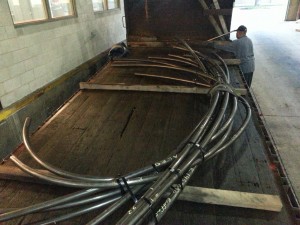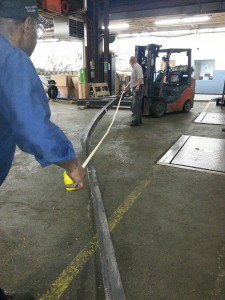Cost is an important factor when shipping any kind of material, but it is especially crucial for curved structural steel. The freight cost can be greatly reduced if transportation can be provided on a common carrier or van as opposed to a flatbed truck.
The main issue when determining whether or not an article can ship via common carrier as opposed to a flatbed is floor space. As long as the article can be loaded with a fork truck, weight is a secondary consideration, usually no more than 4000# per individual article. The amount of floor space a single item fills determines how much other freight can be loaded next to and around the piece inside of a closed trailer. Common carrier truck companies need to fill the square footage of each trailer with as much freight as possible to be profitable; therefore, the larger a single article is the more difficult filling out the trailer becomes.
And filling out a trailer can be a problem with curved material because of the chord length versus the rise on the radius as opposed to a straight line. One piece of curved angle can be relatively light. However, if the rise on the angle is over 5′ and the chord is over 20′ it will consume a vast amount of floor space on the trailer when laid flat.
It is possible for items that are around 200lbs or less to be leaned against and strapped to the wall inside the trailer if the rise is 7′ or less. This is often the case when shipping a small tube or angle that has a large rise and long chord length. However, this becomes more difficult to do as the weight, size, and number of pieces increase. It is important to know that the vast majority of truck lines use a 28′ pup (trailer) to transport freight over the road. This means that the maximum chord length of a single piece of material or bundle should be no longer than 20ft. Multiple radii and multiple bundles also increase the amount of necessary floor space. If a piece of material is over 20′ long, trimming or cutting the piece in half is necessary in order to ship on a closed van. The factor to be considered when making the decision as to whether or not to cut something in half is the cost of welding the piece back together versus the increased shipping cost of using a flatbed truck.
There is one other factor to be considered when making the determination of shipping on a common carrier: the overall strength of the material. The longer a piece of curved steel is the easier it becomes for it to be bent and damaged in transit. Of course the smaller the dimensions of the rolled piece the more “flimsy” it becomes. But even a 6″ x 4″ x 3/8 angle can be damaged when it is being loaded and unloaded with a fork truck.









